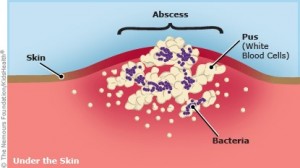
Skin Abscess by Vanessa Fitzgerald
 What is a skin abscess? A skin abscess, is a confined pocket of pus that collects in tissues, organs, or spaces inside the body. When an area in the body becomes infected, the body’s immune system sends white blood cells to fight the infection. These cells collect and combine with the damaged tissue and germs, creating a liquid called pus. An abscess is characterized by a painful, swollen lump that’s filled with pus. A boil is a skin abscess, but not all abscesses are necessarily boils.
What is a skin abscess? A skin abscess, is a confined pocket of pus that collects in tissues, organs, or spaces inside the body. When an area in the body becomes infected, the body’s immune system sends white blood cells to fight the infection. These cells collect and combine with the damaged tissue and germs, creating a liquid called pus. An abscess is characterized by a painful, swollen lump that’s filled with pus. A boil is a skin abscess, but not all abscesses are necessarily boils.
Who is likely to get an abscess? Just about anyone can get an abscess. It is very common in all ages, there are more than 200,000 US cases per year. Those with weakened immune systems, dirty environments, or poor hygiene are more likely to get them.
What are the causes of a skin abscess? The usual cause of an abscess is an infection containing bacteria. Certain bacteria are more likely to be ‘pus-forming’ as they make chemicals (toxins) that can damage the body’s tissues. This can occur from minor skin punctures which get under the skin into oil (sebaceous) or sweat glands.
What are the symptoms of a skin abscess? Most symptoms are pimples or redness. Also common are pus, painful lump, tenderness, swelling, or swollen lymph nodes. They are painful to the touch and can appear anywhere on the body.
How do you treat a skin abscess? Treatments include draining the abscess an antibiotic treatment. An abscess is treatable by a medical professional. Here are some medical procedures:
- Incision and drainage, removal of unhealthy tissue, and procedural sedation and analgesia (painkiller).
- Cutting or puncturing the skin to drain an infection such as an abscess or boil.

- Removal of unhealthy tissue.
- Removal of dead, damaged, or infected tissue from wounds to promote healing.
Here are some common antibiotics that help stops the growth of or kills bacteria:
- Clindamycin
- Sulfamethoxazole / trimethoprim
How to prevent getting a skin abscess: To avoid getting an abscess, maintain good personal hygiene by washing the skin with soap and water regularly. Avoid cutting oneself when shaving the underarms or pubic area.
The information provided is for general interest only and should not be misconstrued as a diagnosis, prognosis or treatment recommendation. This information does not in any way constitute the practice of medicine, or any other health care profession. Readers are directed to consult their health care provider regarding their specific health situation. Marque Medical is not liable for any action taken by a reader based upon this information.
